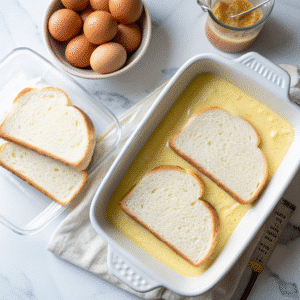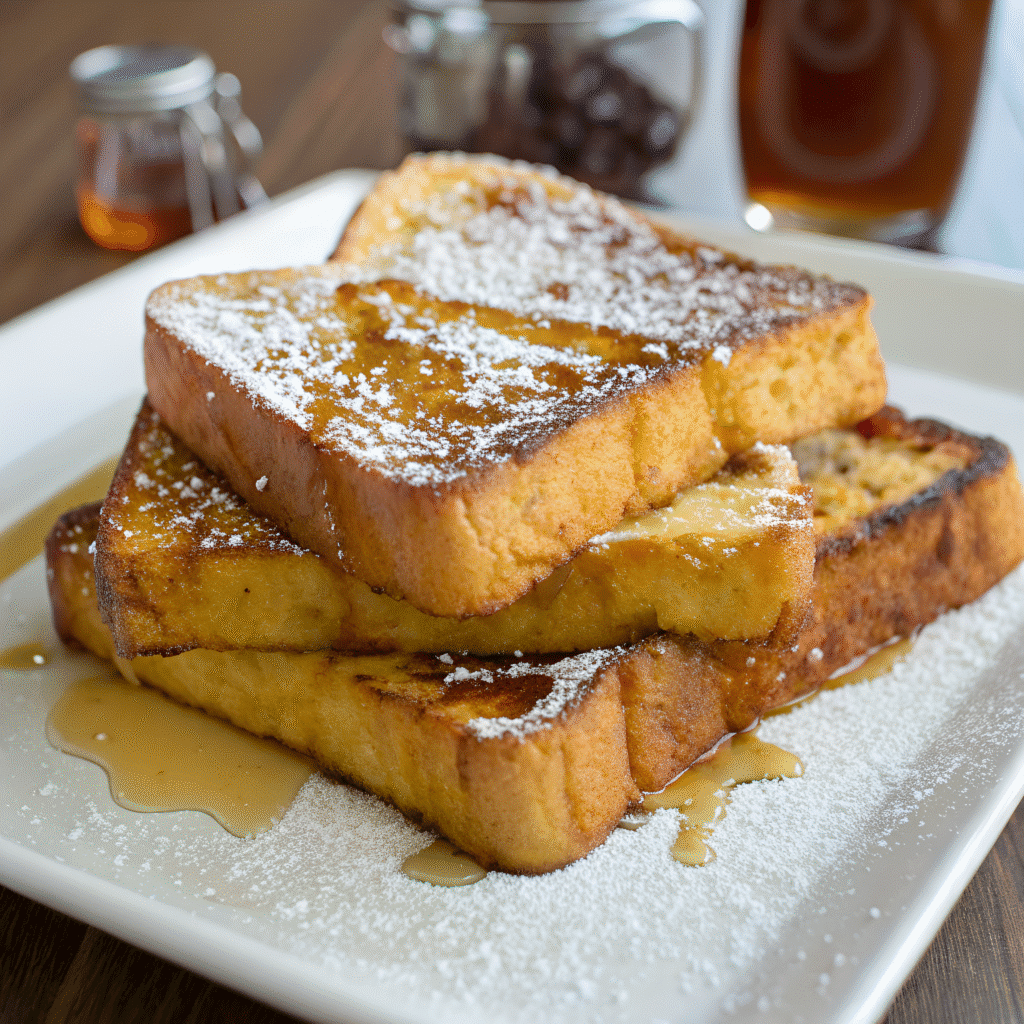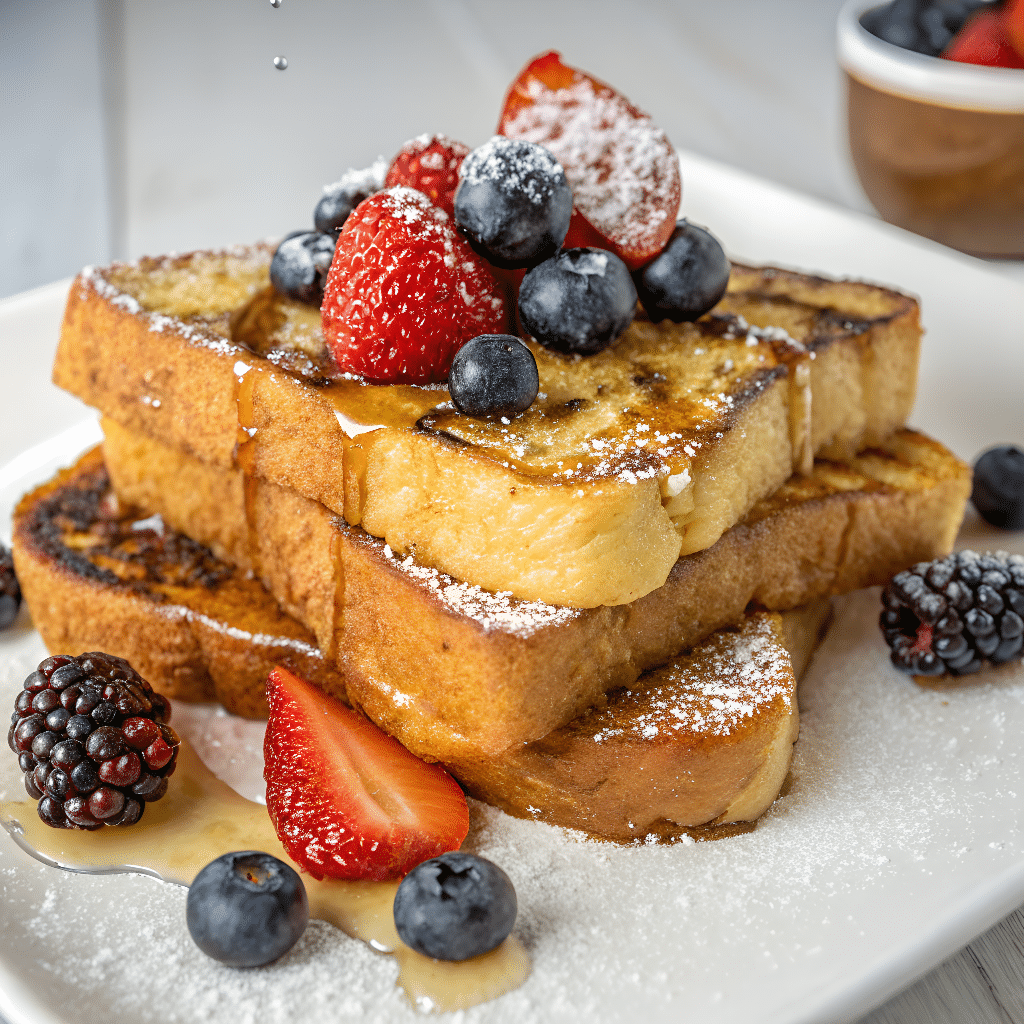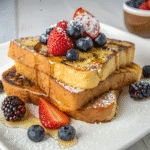Table of Contents
Table of Contents
Introduction
As a child in Georgia, mornings started with chatter and the smell of French toast. My mom dipped thick bread in eggs and milk, adding a little vanilla and cinnamon, her hands moving quickly. It was our special treat, made for family and friends alike. Now, I love passing that tradition to you French toast that’s crisp outside, tender inside, and topped just how you like. Whether it’s a slow Sunday or a quick weekday breakfast, one bite brings back laughter and warmth. Gather around your table and let this recipe become a part of your family story.
Making French toast is more than just a weekend treat it’s a little trip back to my family kitchen in Madison, Georgia. I remember Mom whisking eggs while I dipped thick slices of bread, both of us laughing as we tried not to make a mess. There was always sweet tea in hand and folks dropping by, drawn by that cozy aroma wafting down the street. I believe toast brings people together. It’s the kind of dish anyone can make their own, yet the right technique makes all the difference.
Today, I’ll show you my creative twist on classic French toast, just like we’d make for Sunday breakfasts or those lazy summer brunches. With simple pantry ingredients and a few expert tips, every slice turns out crisp at the edges and soft inside perfect for gathering around your table. You’ll find links to brunch classics and breakfast inspirations right from the Deliciousavors.com kitchen, so you can keep that Southern hospitality cooking all week long.
PrintFrench Toast: The 7 Remarkable Steps For Perfect Breakfast
Classic French toast with a Southern twist: golden, fluffy, and full of flavor.
- Prep Time: PT0H10M
- Cook Time: PT0H15M
- Total Time: PT0H25M
- Yield: 4 servings
- Category: Breakfast
- Method: Stovetop
- Cuisine: Southern
- Diet: Vegetarian
Ingredients
8 slices brioche or challah bread
4 large eggs
1 cup whole milk (or half-and-half)
2 tablespoons sugar
1 tablespoon all-purpose flour
1 teaspoon vanilla extract
1 teaspoon ground cinnamon
1/4 teaspoon salt
2 tablespoons butter (for frying) Toppings: berries, syrup, powdered sugar

Instructions
Étape 1: Whisk eggs, milk, sugar, vanilla, cinnamon, salt, and flour in a shallow bowl.
Étape 2: Dip each bread slice into custard, soaking well on both sides.

Étape 3: Heat butter on a skillet over medium. Place slices in skillet.
Étape 4: Cook until golden, 2–3 minutes per side. Don’t overcrowd pan.

Étape 5: Serve hot with toppings of choice: berries, syrup, powdered sugar.
Notes
Use slightly stale bread for best results. Double the recipe for a crowd. Store leftover slices in freezer. Try adding orange zest for brightness.
What Makes French Toast Truly Great: A Southern Kitchen Story
Family Memories with French Toast
French toast feels like both a celebration and a comfort. Growing up, it meant crowding the kitchen with my mother and siblings while we mixed up the batter. I still hear breakfast chatter echoing, the sound of a spatula flipping golden bread in a sizzling skillet. What made it most special? Sitting down together, sharing stories and maybe sneaking an extra slice before anyone noticed.
The scent of cinnamon and vanilla still takes me back. Over the years, I’ve tried every trick for top-notch French toast thick breads like brioche, a pinch of salt, sometimes a little cream for extra richness. The recipe just below is one I settled on after plenty of trial and error and a few burnt attempts! French toast is forgiving, welcoming tweaks and new flavors. It’s all about what you and your family enjoy.
The Secret to Good French Toast
The real secret is a combination of fresh and day-old bread, a balanced ratio of eggs to milk, and a touch of flour if you want that restaurant-style fluffiness. Leave your bread out overnight to give it a hint of chew and let it soak in the custard fully without getting soggy. Cinnamon and vanilla are essential for warmth and depth, while a pinch of salt pulls all the flavors together. You get crisp, tender slices that stand up to maple syrup or your favorite toppings. For extra decadence, try swapping in half-and-half or even adding a quick splash of orange zest.
Classic French Toast: Ingredients & Simple Steps
French Toast Staples You’ll Always Find in My Kitchen
A delicious plate of French toast starts with simple ingredients, and the best part is you probably already have them in your pantry. At the core, you need:
- Bread, preferably thick-cut like brioche or challah
- Large eggs for rich custard
- Whole milk or half-and-half for creaminess
- Vanilla extract for that classic aroma
- Ground cinnamon for subtle spice
- Pinch of salt to round out flavors
- Touch of sugar for sweetness
- Butter for griddling
Ingredient Table
| Ingredient | Purpose |
|---|---|
| Brioche (or thick white bread) | Absorbs custard, creates fluffy texture |
| Eggs | Binds and enriches batter |
| Milk or half-and-half | Adds creaminess and soft texture |
| Vanilla & cinnamon | Adds depth and warmth |
| Pinch of salt | Balances flavor |
Step-By-Step for the Best French Toast
Start by whisking your eggs, milk, sugar, cinnamon, vanilla, and a little flour in a shallow bowl. Ensure the mixture is well-combined and smooth. Dip slices of bread and let them soak briefly on each side stale or dry bread needs an extra second for optimal absorption. Melt butter in a skillet or on a griddle over medium heat, and cook each slice until golden, about 2-3 minutes per side. Serve promptly, piled high with fresh fruit, powdered sugar, or a drizzle of maple syrup.
Fluffy Secrets and Helpful Variations
French Toast Secrets from Chefs and Home Cooks
True restaurant-style French toast includes a handful of clever tweaks. Many use a small scoop of all-purpose flour in the egg mixture to thicken the custard this adds a slight “batter” and helps prevent soggy centers. A secret from Southern diners: let your bread soak just long enough to absorb the custard but not fall apart. Use a blend of whole eggs and sometimes an extra yolk for creamier results. If you love an extra punch of flavor, try grating a bit of orange zest right into the mix.
Another winning move? Use butter for the golden crispy outside and, if you want the edges perfectly crisp, finish your slices in a low oven for a couple minutes to set the texture.
French Toast Tips from Jamie Oliver and More
British chef Jamie Oliver puts his twist on French toast by grilling thick-sliced brioche, soaking it with a cinnamon-orange custard, and topping with grilled stone fruits. It’s all about fresh ideas and seasonal toppings think peaches, plums, or even a sprinkle of shredded coconut for crunch. Jamie suggests orange zest in the custard for a lift and serving with Greek yogurt and fresh berries for balance. The combination brings tart, sweet, and creamy together breakfast perfection.

Modern French Toast: Make-Ahead, Freezer Tips, and FAQ
Make-Ahead Toast for Busy Mornings
If you’re up before sunrise or feeding a crowd, you can dip your bread slices ahead of time, place them in a single layer on a baking sheet, cover well, and refrigerate overnight. In the morning, cook them straight from the fridge for a fuss-free brunch.
Cooled leftover slices freeze beautifully. Stack them with wax paper between each, seal in zip-top bags, and pop into the freezer. To reheat, toast in the oven or toaster oven for a few minutes no soggy slices or loss of crispness.
Two More Must-Try French Toast Techniques
- Use stale bread for classic “pain perdu” this holds up much better and soaks up the custard.
- For a crunchy edge, press each slice in fine breadcrumbs or shredded coconut after dipping, then fry as usual.
Table for Make-Ahead Tips
| Technique | Result |
|---|---|
| Refrigerate dipped slices overnight | Ready for quick cooking in the morning |
| Freeze cooked slices | Batch breakfasts, great for meal prep |
FAQ: All About the Best French Toast
What is the secret to good French toast?
A mix of stale (or lightly dried) bread, balanced custard (eggs to milk ratio), a dab of flour in the mixture, and letting the bread soak just the right amount creates French toast that is crisp outside and soft not soggy inside. Butter for frying gives that restaurant-style finish.
What ingredients are in a French toast?
How do you make toast easy?
Conclusion
French toast is a dish you can always count on for warmth, simplicity, and a moment to gather around the breakfast table. With classic Southern hospitality, this recipe celebrates both tradition and little creative twists. From the first bite, you taste comfort and care. You don’t need fancy skills just a little patience, a steady hand with the custard, and an appetite for good food and good company. So turn on your favorite music, fire up that skillet, and make some memories of your own. And if you’re hungry for more, my site is filled with inviting breakfast treats and kitchen wisdom passed down or sometimes invented on the spot!
For more recipes, visit my Facebook page.

